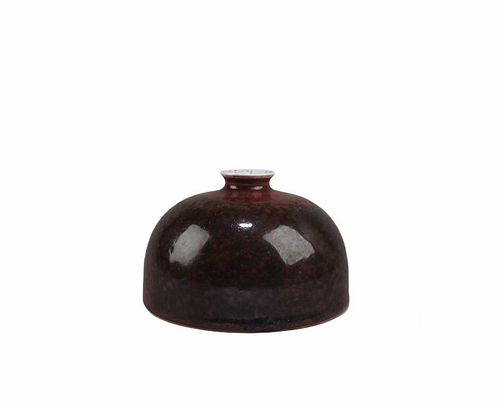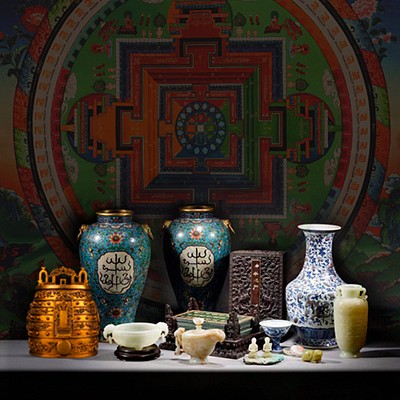A Rare Kangxi peach-bloom water pot
About Seller
5091 Walnut Grove Ave
San Gabriel, CA 91776
United States
For over 30 years, Jumbo Auction House has been dedicated to curating collections of unique works of art for art lovers, decorators, novice collectors and fellow experts alike.
Two ways to bid:
- Leave a max absentee bid and the platform will bid on your behalf up to your maximum bid during the live auction.
- Bid live during the auction and your bids will be submitted real-time to the auctioneer.
Bid Increments
| Price | Bid Increment |
|---|---|
| $0 | $10 |
| $100 | $25 |
| $500 | $50 |
| $1,000 | $100 |
| $2,000 | $200 |
| $3,000 | $250 |
| $5,000 | $500 |
| $10,000 | $1,000 |
| $30,000 | $2,500 |
| $50,000 | $5,000 |
About Auction
Aug 6, 2022
Jumbo Auction House is proud to bring you items of enticing Chinese works of art from private collection legacy, including important jade, bronze, cinnabar lacquer, paintings, jewelry, soapstone, snuff bottles, statues, porcelain vases, carvings, coins and much more! Jumbo Auction House jumboauction@yahoo.com
- Lot Description
Peach-bloom glaze is called cowpea red glaze in Chinese. A tiny change in the firing temperature or aerobic condition can create various color from mellowed grayish-pink to green, to intense red and dark red, or to a combinations of spots of black and/or green mingling in a red ground, as exemplified by this pot. These patterns are artistically interesting and treasured. Peach-bloom glazed porcelain is one of the most difficult porcelain to make. Thus peach-bloom porcelain was made primarily during Kangxi reign (1622-1722 AD), as small scholar objects primarily for imperial palace use. The shape of this pot is called Tai Bai Zwen (Tai Bai refers to the great poet Li Tai Bai). These wares have command extreme high value, due their artistically pleasing, their use by the imperial court, and their rarity. During late 19th and early 20th century, majority of them were acquired by major Western Museums; genuine ones hardly exist in private hands. Such high value unavoidably creates imitations during late Qing and in modern days in mainland China as well as Taiwan (where imitation artists can learn closely from the genuine samples in the Taipei’s National Palace Museum). Luckily, the imitations can be differentiated. The glaze covering the base and areas inside mouth rim of late Qing imitations is rougher, too white, too clear/ transparent, and glaring (?????????. The foot rims of late Qing imitations are also rougher. The modern imitations made in Taiwan are frightening realistic; even experts sometimes are cheated. But subtle differences exist. The modern imitations’ surface is often shinny (?????????) and perfectly even. The glazes are also more even in color, usually red; but the Kangxi’s is usually not very uniform in color, many with brown, black, and green spots. Using your finger to scrape the surface of modern imitations you get a sticky feeling like scraping newly made glass surface. The genuine Kangxi porcelain’s surface is not perfectly even and without giving the sticky feeling as you scrape it; rather you get a feeling like scraping a semi- or fully-polished jade surface. The glaze on modern imitations’ outer base is also more clear/whiter/transparent than the genuine. The genuine Kangxi porcelain’s counterpart has a pale bluish-green tin, close to the color of lake water-green (???)of Yin Chin wares of Song and Yuan, and has more minute bubbles/cloudy inclusions, visible under magnification, which make the glaze slightly milky. The modern imitations’ marks are usually more intense blue and closer to the surface of the glaze, as compared to the mellowed and pleasant blue that appears beneath the milky/cloudy glaze, showing a distant to the glaze surface (in Chinese connoisseurs’ term not piau foa (?? floating on the surface)). The imitations’ foot rims are too white; the genuine Kangxi porcelain’s usually appears pale grayish white and has some light brownish red dots that can be seen under magnification. The modern imitations of the same size are usually slightly lighter. The differences around the mouth rim and inside are even more dramatic and can be seen in the photos here (mouth rim of this pot) and by putting a probe light inside. From Dr. Robert I-San Lin (#2031), a senior Chinese artwork appraiser, whose grandfather was a major Chinese antique merchant in early 1900s. (Dr. Lin’s bio, in Journal of Authentication of Artworks, 2015, available). Brought to California in 1960s. H. 8.8, dia. 13.6 cm; 557 grams.NOTE: Any condition statement is given as a courtesy to a client, is only an opinion and should not be treated as a statement of fact. Jumbo Auction House shall have no responsibility for any error or omission. The absence of a condition statement does not imply that the lot is in perfect condition or completely free from wear and tear, imperfections, or the effects of aging. We do not carry out in-depth research of the sort carried out by professional historians and scholars, and any statements made by us orally or in writing about any lot concerning attribution to an artist, provenance, period, materials, origin, history, or dates represent an opinion of Jumbo Auction House and are not to be relied on as a statement of fact. Such opinions serve for informative purposes only and do not constitute historic or academic scholarship on the works and do not aim to substitute or contradict any such scholarship.
Condition
- Shipping Info
-
No property will be released until payment in full has cleared. Any expense related to packing, shipping and insurance (including reimbursement for damage or loss) of purchased lots is the responsibility of the buyer. Jumbo Auction House does not offer in-house shipping service for MOST items. Please arrange your own shipper to pick up the item(s) or we are happy to recommend shippers to you upon request. The emails of the two local shippers we recommend are on the invoice. Paid-for merchandise must be collected by the buyer or an authorized representative no later than forty-five (45) days following the date of the auction. Any merchandise remaining after this period will be subject to a storage fee of $10 per lot/per day. Please Note: Responsibility and all liability of items as well as safe delivery are assumed by carrier, shipper, buyer, agent or packing company upon acceptance of merchandise. Buyer will not hold Jumbo Auction House liable for any damage or loss after merchandise has been released from our possession.
-
- Payment & Auction Policies
-
Available payment options
-
-
- Buyer's Premium



 EUR
EUR CAD
CAD AUD
AUD GBP
GBP MXN
MXN HKD
HKD CNY
CNY MYR
MYR SEK
SEK SGD
SGD CHF
CHF THB
THB
























